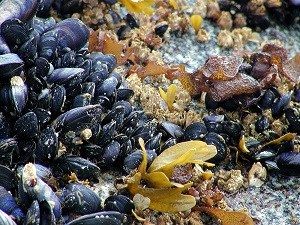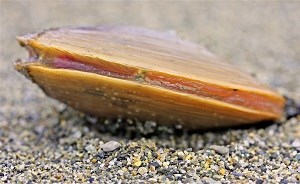
MusselsMussels (Mytilus) are relatives of clams and are commonly found in the middle to lower rocky zones attached to rocks by strong threads which the animals secrete. Blue-black in color, mussels are filter feeds. They feed by passing sea water over a filtering structure (the gill) which removes organic particles and small organisms like plankton and pass them on to the mouth. While in many areas mussels are a popular food source for people, one must use caution with the mussels of Bartlett Cove. They are edible during parts of the year, but in the summer and fall they may become poisonous. One of the tiny organisms that blooms in the plankton is a dinoflagellate (Gonyaulax) which secretes a potent toxin. The toxin does not affect the mussels, but they accumulate it and may store it for a month or more. A single heavily tainted mussel is sufficient to kill a person. This syndrome, paralytic shellfish poisoning, is a serious danger over most of the Pacific Coast and mussels and other filter feeding clams should be eaten with due care during summer. Mussel beds provide a home for many other organisms which live in the protected spaces between mussels. Mussel beds can become so thick that they overgrow other sessile animals like barnacles. 
ClamsSeveral different clam species live in Bartlett Cove, usually only the shells of dead clams are noticed at first. Live clams can be found by digging in the mud flats. Many of the holes in the mud are openings through which water is pumped to and from the bodies of the clams. The circulated water brings both food and oxygen to the gills. Most clams are filter feeders, and remove plankton from the water with their gills. Like mussels, the filter feeding clams concentrate the toxin of paralytic shellfish poisoning, and so should not be eaten in the summer unless they are positively known to be untainted. Cockles (Clinocardium) range from the Bering Sea to Baja, California. They can be recognized by the heavy ribs radiating from the hinge of the shell. Unlike other clams, cockles have no siphon tubes. Because of this, they live very close to the surface of a mud or sand flat. An exposed cockle can bury itself very quickly if disturbed and can actually “hop away” from starfish. It moves by manipulating its large muscular “foot”- an interesting process to watch. The littleneck clam (Protothaca) gets its name from its short siphons or “neck” and is best identified by shell ribs radiating from the hinge and running parallel to the margin. These clams can reach very high densities and are perhaps the best tasting of the local bivalves. The occasional geyser-like spurts of water, coming from the rapid contractions of these clams, are often seen on the beaches and can shoot several feet into the air. Butter clams are common large clams with thick shells showing fine ribbing parallel to the margin. Although very tasty, they store paralytic shellfish poisoning for long periods of time and should be eaten with due caution. Bent-nose clams are abundant in soft sediment areas. Their thin shells rarely exceed a couple of inches in length and, when looked are from above the hinge, are distinctly bent to one side. Bent-nose clams are often buried at a depth of a foot or more, and feed through a long worm-like siphon. Though generally safe to eat, they tend to be sandy. |
Last updated: March 16, 2018
